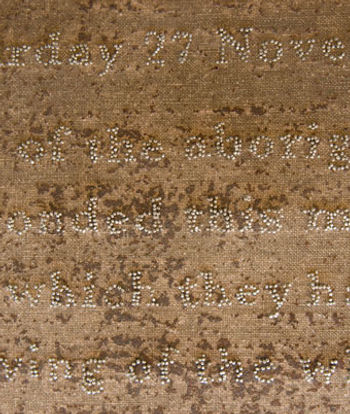CASE STUDY

Detail, The chase, 2008.
Julie Gough
Julie Gough is an artist, writer and curator who lives in Hobart, Tasmania. She was born in Melbourne in 1965.
The chase is a well-worn chaise impressed with a text made from tens of thousands of pins and burnt tea tree stick spear legs.
The text says:
"Saturday 27 November 1830. The Hobart Town Courier. Two of the aborigines who have been living so long at Mr Robinson’s ... absconded this morning, after divesting themselves entirely of the clothing given to them ... They were encountered in the bush by two broom makers, one a cripple, who succeeded in taking them. The blacks made every effort to escape. Several persons at work in the bush fled at the sight of them. Nothing can tame them."
Artist quote:
"The chaise … usually represents, for me, the ambit comfort of the upper classes in ‘settling’ into a supposedly colonised Van Diemen’s Land. Furniture … represent[s] … contact with the past of the colonisers, to read how they occupied their newly invented properties. The pins represent … change and … a tool of a seamstress who make[s] the clothes that the Aborigines in this story so quickly divest themselves of ...
"The palpable surfacing of Hobart Town’s fear is evident in the text: ‘Nothing can tame them.’ It reveals publicly how well received will be the intention of the Government to officially remove all Tasmanian Aboriginal people the following year in the ‘Black Line campaign’ of 1831.
This contemporary viewer/reader’s precognition of what will happen to Tasmanian Aboriginal people in the subsequent century—post 1830s Bass Strait banishment— rests uneasily with the abject humour in the text openly contradicting itself, admitting that a cripple managed to capture the two ‘untameable’ Aborigines."
Julie Gough 2008
Text © National Gallery of Australia, Canberra 2010


Julie Gough, The chase, 2008.
Assemblage, leather, tea tree wood and steel pins
Installation 97.0 h x 182.0 w x 52.0 d cm